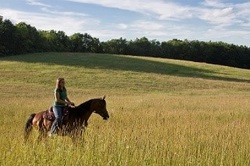

High quality, rare, or significant natural communities present within the recreation area include southern sedge meadow, shrub-carr and a shallow hard drainage lake emergent aquatic community. Two rare, plant species—white lady’s slipper and yellow giant hyssop have been documented. The most common wildlife species seen throughout the recreation area are deer, turkey, sandhill cranes, hawks, pheasant, fox, and a variety of waterfowl. The Area also includes Upper Mud Lake with an abundance of pan fish.

Bicycle access to the recreation area is special due to its central location. Trails link to a number of regional bicycle trail systems, including the Military Ridge, Badger, and Glacial Drumlin State Trails and making the recreation area a hub for the region. A number of spur trails and bridges have been cleared by the Friends of Capital Springs and Dane County to improve pedestrian and bicycle connectivity to adjacent residential areas. To be completed by 2017, a new bridge and trestle will use an existing railroad grade to cross Lake Waubesa and provide bicycle/pedestrian access to the Village of McFarland and beyond. Additionally, Upper Mud Lake is one of the most popular spots for fishing year-round in Southern Wisconsin.
Units of The Recreation Area Include:
The Lewis E-Way: The Capital Springs Recreation Area follows the land identified by the visionary Professor Phillip Lewis. The E-Way, is a unique Environmental corridor with land and water resources, It provides a wonderful Ecological and cultural mixture at Lake Farm Park and a venue for Education and Exercise. The E-Way gives us a place to reflect and enjoy the Esthetic natural beauty around us..
The Jenni and Kyle Preserve: Located on Post Road, it is special place within the recreation area, designed to be used by people who have physical and mental challenges. The mural erected there is beautiful.
The Nevin Fish Hatchery: Located near the west end of the Park and operated by DNR, this historic building is still functioning as a regional fish hatchery growing many of Wisconsin's game and recreational fish.
Lake Farm County Park: The signature park in the Recreation Area covering 380 acres of archeologically significant land and Lakeshore as well as the Lussier Heritage Center. The Park provides diverse recreational opportunities.
Capital Springs State Shoreline: The beautiful area immediately south of Lake Farm Park provides views of beautiful Lake Waubesa, hiking trails along the shore and out to Hogg Island, a special peninsula jutting out into the Lake.
MMSD Wildlife Observation Unit: Located in the North part of the Area, the unit provides unique opportunities for wildlife observation and is a destination for birding year-round.
Disc Golf and Dog Exercise Area: Developed by the County, and located in the southern part of the Area, these amenities are popular destinations for many.
Capital City State Trail: Traversing the Recreation Area, the trail is one of the main arteries in the park providing bicycling trails connecting to many other local and regional trails.

Capital Springs is managed by several units of government including Dane County, the Wisconsin Department of Natural Resources, the Madison Metropolitan Sewerage District, the Cities of Fitchburg and Madison. Shared ownership provides opportunities and challenges. The Recreation Area Management Agreement formally vests the role of coordinating and planning for the Recreation Area in the Friends. The Friends provide the consistent vision and coordination as well and the ability to leverage financial resources. Moreover, the Friends have been the focus for engaging the community in this unique resource. In addition to fund raising, the Friends developed partnerships with MMSD and other municipalities, conducted significant invasive removal and stewardship of the land and water, sponsored community outreach activities, facilitated educational tours, water quality monitoring and cultural events.





 RSS Feed
RSS Feed